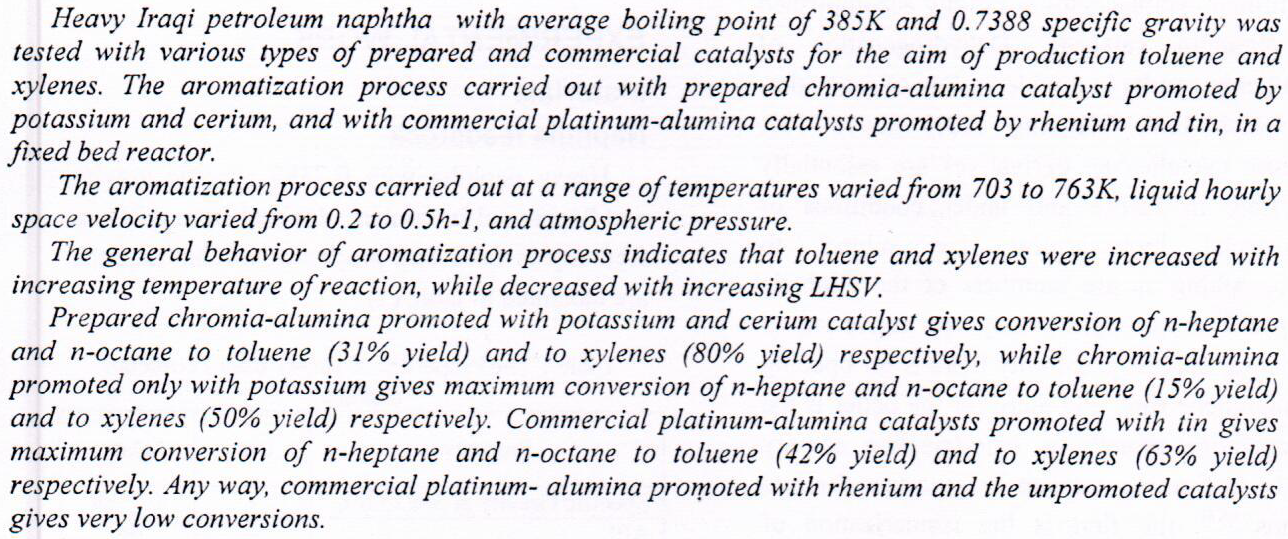
Salivary peroxidases have biological functions of particular importance to oral health. The aim of this paper is to shed the light on saliva and serum total peroxidases activity as well as the activity of each of salivary peroxidase (SPO) and myeloperoxidase (MPO) in patients with oral tumors. The studied participants were divided into two groups: the first group included 18 oral squamous cell carcinoma patients and 20 age and gender-matched healthy controls while the second group consisted of 20 oral ossifying fibroma patients and 23 age and gender-matched healthy controls. Total peroxidases activity was determined, and its specific activity was calculated in serum and whole mixed saliva as well as in the supernatant and pellet fractions
... Show More (2)
(2)
This work involves theoretical and experimental studies for seven compounds to calculate the electrons spectrum and NLO properties. The theoretical study is done by employing the Time Depending Density Functional Theory TD-DFT and B3LYP/high basis set 6-311++G (2d,2p), using Gaussian program 09. Experimental study by UV/VIS spectrophotometer device to prove the theoretical study. Theoretical and experimental results were applicable in spectrum and energy gap values, in addition to convergence theoretically the energy gap results from ΔEHOMO-LUMO and UV/VIS. spectrum. Consider the theoretical method very appropriate to compounds that absorb in vacuum UV.
 (2)
(2)
 (2)
(2)
 (3)
(3)
 (2)
(2)
 (3)
(3)
 (3)
(3)
 (15)
(15)
 (16)
(16)
The study is concern on determine the type of Candida spp.in leukemia patients that were infected with oral candidiasis as a result to their immune suppression (weekend immune system) due to their submission to radiation and chemotherapy treatment. The result showed that the most common isolates were C. guillermondii 19 which represent 31.66% of cases, then followed by C. itermedia 11 which represent 18.3%, while the less common isolates were for C. zeylamodes 3 which represent 5%.
Objective: To evaluate and compare the effect of mechanical surface treatment (groove, aluminum oxide particles)
with 45 degree bevel type of joint on tensile bond strength of acrylic specimens repaired by two curing methods
(microwave and water both).
Methodology: Eighty specimens (80) were prepared from pink heat cure acrylic resin. They were divided into two
main groups (40 specimen repaired by microwave energy and 40 specimens repaired by water bath method).Each
group can be divided into four subgroups of ten according to the surface treatment. The control group A was left
intact, group B received no surface treatment, group C and D received surface treatment by (groove, 50 m aluminum
oxide particles). Specimens
Background: Ceramic veneers represent the treatment of choice in minimally invasive esthetic dentistry; one of the critical factors in their long term success is marginal adaptation. The aim of the present study is to evaluate the marginal gap of ceramic veneers by using two different fabrication techniques and two different designs of preparation. Material and methods: A typodont maxillary central incisor used in the preparation from which metal dies were fabricated, which were in turn used to make forty stone dies. The dies divided into four experimental groups, each group had ten samples: A1: prepared with butt-joint incisal reduction and restored with IPS e.max CAD, A2: prepared with overlapped incisal reduction and restored with IPS e.
... Show MoreBackground: Prophylaxis methods are used to mechanically remove plaque and stain from tooth surfaces; such methods give rise to loss of superficial structure and roughen the surface of composites as a result of their abrasive action. This study was done to assess the effect of three polishing systems on surface texture of new anterior composites after storage in artificial saliva. Materials and methods: A total of 40 Giomer and Tetric®N-Ceram composite discs of 12 mm internal diameter and 3mm height were prepared using a specially designed cylindrical mold and were stored in artificial saliva for one month and then samples were divided into four groups according to surface treatment: Group A (control group):10 specimens received no surfa
... Show MoreBackground: The marginal adaptation has a key role in the success and longevity of the fixed dental restoration, which is affected by the impression and the fabrication techniques .The objective of this in vitro study was to evaluate and compare the marginal fitness of lithium disilicate crowns using two different digital impression techniques (direct and indirect techniques) and two different fabrication techniques (CAD/CAM and Press techniques). Materials and Methods: Thirty two sound upper first premolar teeth of comparable size extracted for orthodontic reason were selected in this study .Standardized preparation of all teeth samples were carried out with modified dental surveyor to receive all ceramic crown restoration with 1 mm deep
... Show More (2)
(2)
